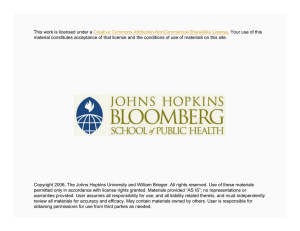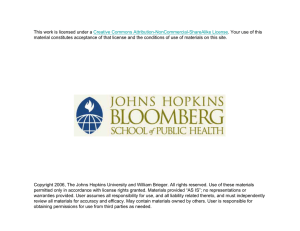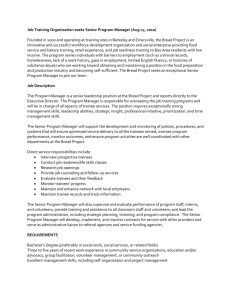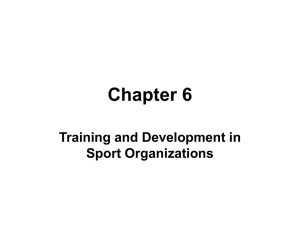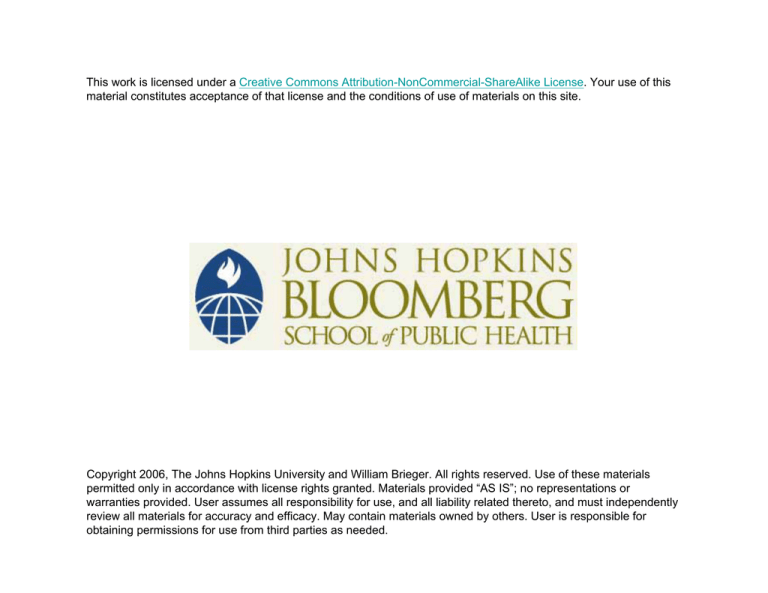
This work is licensed under a Creative Commons Attribution-NonCommercial-ShareAlike License. Your use of this
material constitutes acceptance of that license and the conditions of use of materials on this site.
Copyright 2006, The Johns Hopkins University and William Brieger. All rights reserved. Use of these materials
permitted only in accordance with license rights granted. Materials provided “AS IS”; no representations or
warranties provided. User assumes all responsibility for use, and all liability related thereto, and must independently
review all materials for accuracy and efficacy. May contain materials owned by others. User is responsible for
obtaining permissions for use from third parties as needed.
The Process Continues
William Brieger, MPH, CHES, DrPH
Johns Hopkins University
Section A
Utilizing Evaluation Information
Audiences for Evaluation
Program developers
For redesign, or for
future efforts
The trainers
So they can do a
better job next time
Continued
3
Audiences for Evaluation
The trainees
So that they can
understand the
experience more
fully, account for
deficiencies
Program sponsor(s)
So that they can
decide whether
resources are well spent, and whether to continue
funding
Continued
4
Audiences for Evaluation
Potential recruits
So that they can
decide whether to
apply
Agency managers
So that they can
decide whether the
program met their
needs
5
Assemble Evaluation Information
From the workshop
Process evaluations
Content evaluation
From supervision—performance evaluation
From graduates’ feedback
From technical and professional sources
Critique evaluation instruments
6
Write a Report
The content: provide details of the training event
being evaluated
Purpose and objectives of the training event
Key content areas and training methods
Dates and time span (put schedule in annex)
Number of trainees, how and where recruited
Sponsors and their contributions
Training team and committee members
7
Training Report
Describe the evaluation methods
Pre-tests and formative data gathering
Describe procedures, instruments, and findings for:
• Process evaluation/monitoring
• Summative/outcome evaluation
• Follow-up/impact evaluation
Continued
8
Training Report
Analyze the findings
Compare baseline and follow-up
Identify areas of achievement and gaps
Provide qualitative information, too
• Feedback from trainees, agencies
Interpret and explain
Use process findings to explain outcomes
For example, maybe materials were in short
supply—hence few could practice new skills
Continued
9
Training Report
Make recommendations
Improvements in the
design
Needs for follow-up of
trainees
Annexes
Schedules, key
handouts, evaluation
instruments,
participant lists, etc.
10
Acting on Findings
Finding
Effective training was the main
reason for acceptable and
excellent performance
Response
Both the training and service
delivery organizations need to
maintain the quality of training
Extend training to other staff
whose duties are similar to
those who were just trained
Apply lessons learned about
effective methods, etc. to new
courses
Continued
11
Acting on Findings
Finding
Ineffective training was the
main cause of unacceptable
performance
Response
The training organization needs
to improve the training
• Content
• Methods
• Resources
• Logisitics
Continued
12
Acting on Findings
Finding
Response
Both the training or service
A widespread performance
delivery organization or unit
problem was related to the
qualification or characteristics of should focus on:
• Improving the trainee
the trainees, and was not
selection process
correctable by the training
• Adapting the training to
meet the needs of special
groups of trainees
Continued
13
Acting on Findings
Finding
Performance problems were
primarily related to
organizational systems or
procedures, and were not
correctable by training
Response
The service delivery
organization whose staff has
been trained needs to improve
the systems or procedures for
ensuring:
• Trainees have supportive
work environments for
applying acquired KAS
• Focused supervision after
the training to reinforce new
skills
Continued
14
Acting on Findings
Finding
Response
The service delivery
Performance problems were
related to the local government organization must seek ways to
strengthen community
understanding and support of
the program
15
An Example: Health Education Planning Workshop
One of the biggest problems found after the training
workshops was the inability of trainees to secure funds
for planned activities
Follow-up consultation revealed lessons about the
health ministry budgeting processes
16
Addressing Organizational Realities
During subsequent training, trainees asked to:
Bring information about available budget
Plan advocacy for funding on return
17
Village Health Workers Don’t Function
In an early VHW training program, we found that some
months after training, VHWs weren’t performing
Community members were not interested in the health
education and prevention tasks unless VHWs would also
treat illness
18
Community Responsibilities
Subsequent training was
preceded by discussions
with villagers in advance
about their own
responsibilities
Including donating to
stock a village drug kit
19
Peer Educators
An adolescent
reproductive health
education project trained
25–35 peer educators in
each of 10 urban
communities in Nigeria
and Ghana
Six sites were schoolbased while four were
community-based
20
School-Based and Community-Based
Differences found in PE effect: Only the differences
between in-school groups are significant
21
Peer Education Conclusions
Despite equal training, intervention had different
effects in different settings
Learned that social networks of peer educators in
community settings were smaller
Determined that training intervention was less
appropriate for an urban community setting
Followed up with work through community-based
organizations and the media
22
Section B
Continuing Education Revisited
Integrate with Performance Management System
Human resource elements of a performance
management system include:
A written job description for each position in the
organization
Defined supervisory relationships
Regular work planning meetings between
supervisors and their staff
Periodic performance review meetings
Opportunities for training and staff development
24
CE Opportunities Must Be Institutionalized
Opportunities for
continued learning will not
materialize on their own
Ideally, there should be a
training or continuing
education function/unit
designated within human
resources
25
Build Capacity for CE Needs Assessment
Developing simple instruments
Interviews
Observation checklists
FGDs
Develop capacity to collect and analyze
Enable initiative to plan and deliver CE
26
In-House Approaches to CE
Challenging job assignments that prompt self-learning
Structured on-the-job learning
Mentoring
In-house technical presentations to staff
Rotational assignments
Internet: “electronic” training, educational resources
27
CE Resources
Self-study needs to be
enabled through an
agency library or resource
center
Trainers need to consult
with agencies to help
develop this resource
28
CE Needed for Volunteers
Training programs for
community volunteers
may be short in nature
since volunteers cannot
afford to be away from
home for long
Additional sessions can be
offered to build on the
basic training and address
new issues as they arise
29
Volunteers Take Responsibility
The VHW association in Idere took responsibility for
CE
At each fortnightly meeting, one member was
assigned responsibility for reviewing a lesson with
the group
Association leaders met with trainers to explore
new topics of interest: family planning, leprosy,
HIV/AIDS, etc.
30
Volunteers Develop Capacity to Sustain Programs
The association
Made the arrangements for hosting new sessions
Recruited and trained new VHWs
Incorporated them into the association
31
In Closing
People feel motivated and challenged when they:
Have opportunities to learn
Develop new competencies
Assume new responsibilities
Believe that their efforts will strengthen their
careers
32
People Value Learning
Providing these opportunities can also be an important
way for an organization to recognize its employees
Participating in training and learning activities
Increases staff collaboration and teamwork
Can increase overall performance and productivity
Copyright 2005, Bill Brieger and The Johns Hopkins University. All rights reserved. Use of these materials
permitted only in accordance with license rights granted. Materials provided “AS IS”; no representations or
warranties provided. User assumes all responsibility for use, and all liability related thereto, and must
independently review all materials for accuracy and efficacy. May contain materials owned by others. User is
responsible for obtaining permissions for use from third parties as needed. Unless otherwise stated, all photos are
the work of Bill Brieger.
33

